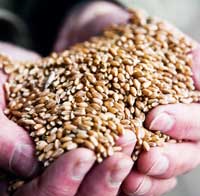Grain prices set for double digit rise

Global commodity prices are on a long-term upward trend, with all the main crops expected to see double-digit price increases over the next five to seven years.
Addressing the Sentry Conference at Chilford Hall, Cambridgeshire, this week, leading economist Prof Harald von Witzke of Humbolt University said farmers had stepped off the “agricultural treadmill” of the past and entered a new world of steadily firming markets.
For all of the 20th century, farmers had faced a situation where rising food consumption had been more than outstripped by increased agricultural output. Farmers’ reward for improving their productivity had been a long-term decline in agricultural commodity prices, he said, with incomes only maintained by subsidies.
That had now changed. Global food demand was expected to double in the first half of the 21st century, driven by population growth and rising incomes.
But the growth in food supply was not keeping pace, in particular due to the limited amount of agricultural land that could be brought into production and because most of the productivity gains available from conventional plant breeding had already been achieved.
Lack of water, increasing demand for biofuels and rising oil prices would exacerbate the food supply problems.
With this tightening market situation, Prof von Witzke predicted “significant” gains in agricultural commodity prices, though with even more volatility around this upward trend line.
Initial research in 2008 had attempted to quantify the extent to which prices would rise between 2005 and 2015, based on various supply and demand assumptions. It concluded that wheat might go up by 14% over the period, maize by 30% and oilseeds by 32%.
“But this analysis had a number of shortcomings,” said Prof von Witzke. In particular, it underestimated the upturn in biofuel production and assumed constant energy prices.
A new analysis has been conducted, assuming the price of oil rises from $45/barrel to $102/barrel by 2017, having a significant impact on production costs and the amount of grain diverted to biofuel production.
On this basis, Prof von Witzke estimated that the price of wheat and oilseeds would increase by about 70% between 2005 and 2017, with maize up by over 100%. “The price of oil has the biggest impact and the days of cheap fuel are over,” he said.
A number of growers at the conference questioned how this was reconciled with the low grain prices they were currently receiving.
Prof von Witzke said that this was the result of the price spikes of 2007, which had stimulated extra production and led to a rebuilding of stocks. But that would readjust next year. “The good news for farmers is that, while we still have fluctuations, the trend is upwards.”

